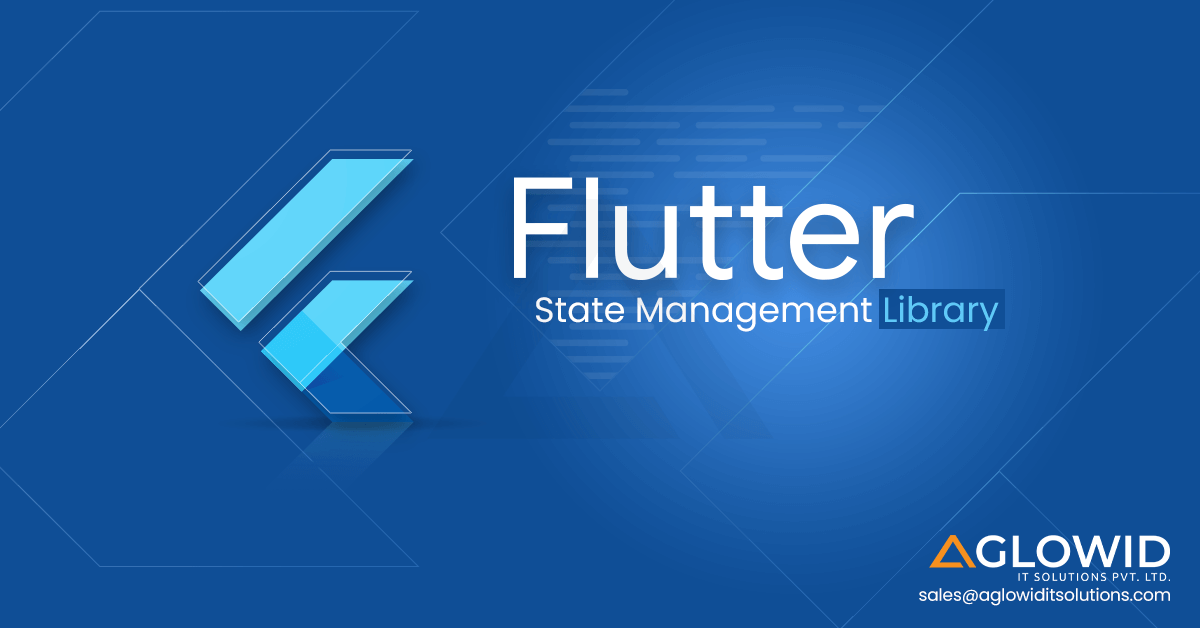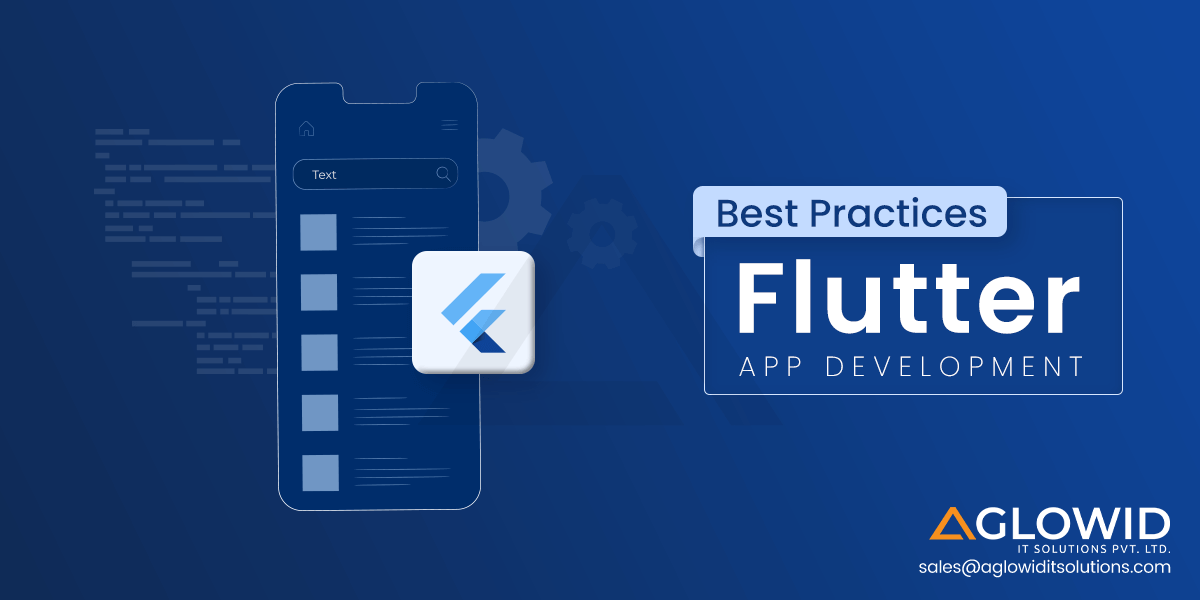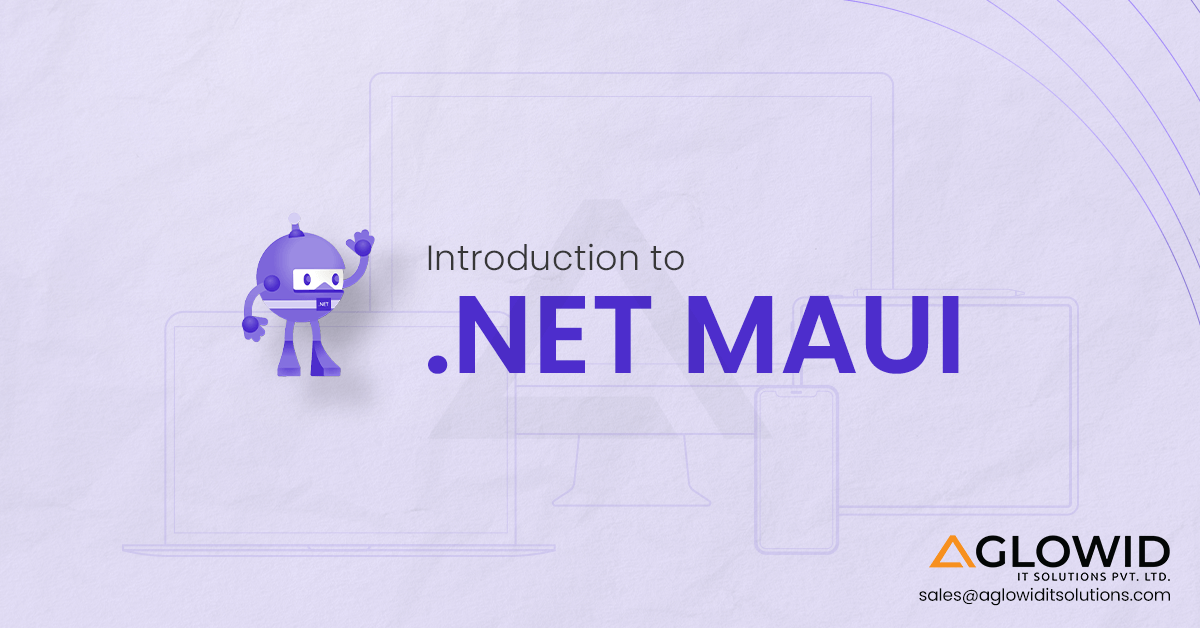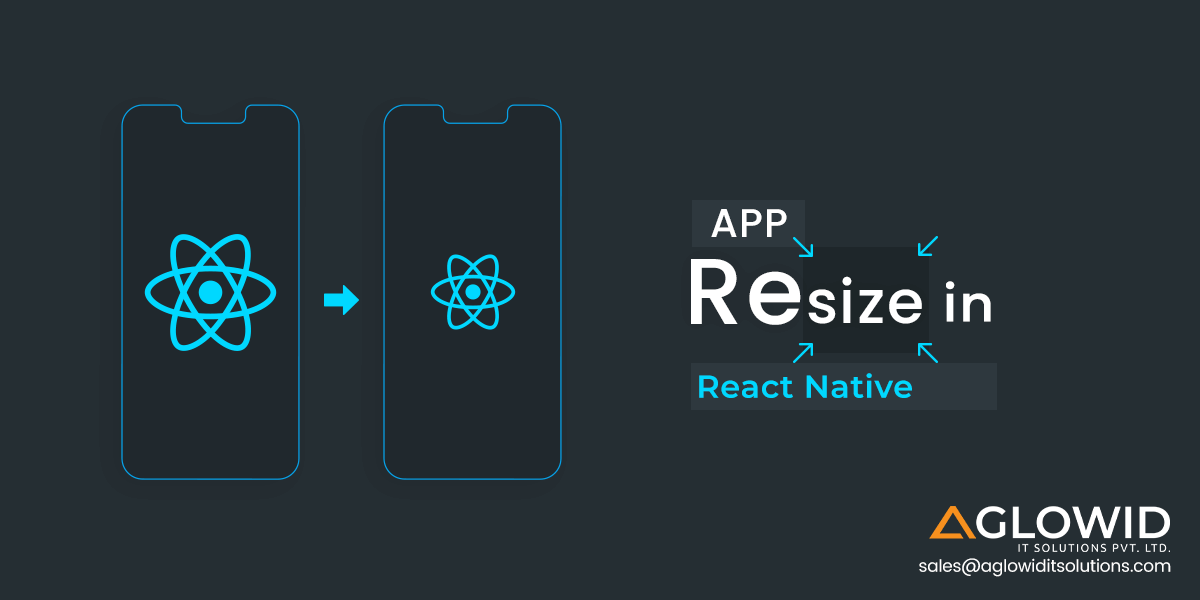Quick Summary:
Flutter State Management Libraries enable the separation of UI and business logic, predictability, promoting code organization and reactivity. These libraries improve testability, scalability and developer productivity with active community and tools for effective debugging. Selecting the right state management library and packages depends on the size and requirements of project.
Flutter state management libraries are crucial for developers managing the dynamic elements of Flutter applications. These libraries help handle state changes—such as user interactions and data updates—by separating the user interface (UI) from business logic, which improves code structure and maintainability.
State management involves keeping and updating the application’s state, which reflects the current UI and data. Libraries facilitate this by providing frameworks and patterns that promote modular code and clarity. They often employ design patterns that clearly delineate UI from logic, enhancing readability and team collaboration.
These libraries also support reactivity, allowing the UI to automatically update in response to state changes, which is key for a smooth user experience. The choice of library depends on project size, complexity, and team needs, with options ranging from simple solutions to those with advanced features for complex state management. Many libraries also include flutter development tools for debugging and profiling, which further support the development process.
Let’s Begin!
What is Flutter State Management?
State management refers to handling and updating data that influences the appearance and behaviour of your app’s UI. This data is called State and can change over time due to user interactions, network calls, or other factors. Effective state management can help ensure that your UI stays synchronized with the application’s current State.

But what makes state management so important?
Here’s the breakdown of what makes the state management an important process for application:

Reactive Approach
Flutter uses a reactive approach for UI rendering. This means that whenever a widget’s state changes, Flutter automatically rebuilds the widget tree according to the changes.
Stateful Widget
Stateful Widgets Are the building blocks of Flutter, which hold state. The State is managed by the corresponding state object associated with the widget.
Complexity Management
It is understandable that when your application grows, the complexity also grows. Therefore, managing the State within the individual widget can create an overhead. This is where state management comes into the play, State management solutions provides a more organized approach to sharing the data between the different parts of UI.
Now that you have brushed up on the concept of State Management in Flutter, let’s see the popular Flutter management libraries that make implementation smooth.
Top Flutter State Management Libraries
When you are looking to hire a Flutter developer, it’s crucial to find someone proficient in state management libraries. These libraries, such as Provider, Riverpod, and Bloc, are game changers in app development. They streamline state handling, making even the most complex state changes manageable. A skilled Flutter developer will know how to leverage these libraries effectively to create scalable, maintainable, and high-performance applications.
Let’s explore some of the most popular Flutter state management libraries:📝
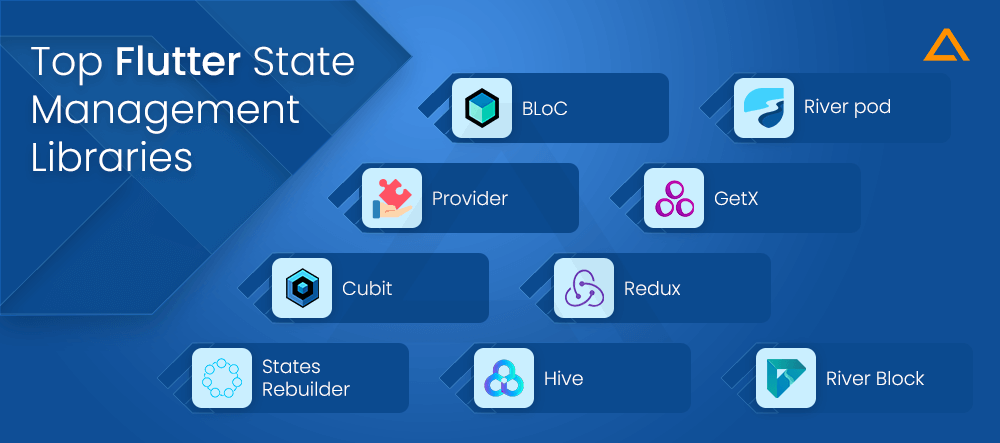
BLoC (Business Logic Component)
| Aspects | Description |
| Dart 3 Compatibility | Yes |
| Null Safety | Yes |
| Platforms Supported | Android, iOS, Web, macOS, Windows, Linux |
| Dart SDK | >=2.12.0 <4.0.0 |
| Latest Version | 8.1.4 (Sep, 2024) |
| GitHub Stars | 11.7K |
| GitHub Forks | 3.4K |
BLoC stands for Business Logic Component is one of the popular state management patterns for flutter applications. It promotes a unidirectional data flow architecture, making your code more organized, testable, and scalable. Here’s the breakdown of key concepts in BLoC:

Events
These represent user’s actions and interactions which can cause any changes in the State of your app. Events are generally implemented as simple Dart data classes.
BLoC
This is the core component in BLoC. It is a class that receives an event, processes it using business logic, and creates a new state based on the event. BLoC can be known as the bridge between the event and the application’s State.
State
This component has the current data which defines the UI’s appearance and behavior. BLoC manages the State and make sure that it stays up-to-date with the events of your applications.
Riverpod
| Aspects | Description |
| Dart 3 Compatibility | Yes |
| Null Safety | Yes |
| Platforms Supported | Android, iOS, Web, macOS, Windows, Linux |
| Dart SDK | >=2.17.0 <3.0.0 |
| Latest Version | 3.0.0-dev.3 (prerelease) |
| GitHub Stars | 6.1K |
| GitHub Forks | 939 |
Riverpod is an emerging library in flutter state management libraries. Developed by the Remi Rousselet, the same developer which has developed Provider. This offers a fresh take on inherited widget with some improvements. Here are the core concepts of River pod:

Providers
Provider serves as the basis for state management in Riverpod, same like Provider does. Data is contained in providers and made available to you across your widget tree.
Customers
Devices that keep an ear out for a provider’s condition modifications. The user interfaces immediately reload with the most recent data whenever the State is updated.
State Provider
State providers are a particular kind of provider made specifically to store and handle state data. Depending on the requirements of your State, River pod provides multiple methods for defining state providers, such as State Provider, Change Notifier Provider, and Future Provider.
Provider
| Aspects | Description |
| Dart 3 Compatibility | Yes |
| Null Safety | Yes |
| Platforms Supported | Android, iOS, Web, macOS, Windows, Linux |
| Dart SDK | >=2.12.0 <4.0.0 |
| Latest Version | 6.1.1 (Nov, 2023) |
| GitHub Stars | 5.1K |
| GitHub Forks | 507 |
The provider is a widely used and lightweight state management solution for Flutter services developed by the Flutter team itself. This simplifies sharing state data across different parts of your UI and encourages a more structured approach compared to using the built-in setState method.
Here are the key concepts in the provider:

Providers
Providers are the binding factors of the supplier. They act as containers that hold and manage the data you want to provide to the widgets in your app. Suppliers can hold a variety of data including simple standards, products, and even third-party suppliers.
Dependency Injections
The provider uses dependency injection to distribute the required data among the widgets throughout the widget tree. This means that widgets don’t need to know how to create or manage the data, they just declare that they trust the provider.
Consumers
The providers of the widgets needed to access the data are the users. Whenever a provider’s data changes, they use the Consumer widget to recreate their own.
GetX
| Aspects | Description |
| Dart 3 Compatibility | Yes |
| Null Safety | Yes |
| Platforms Supported | Android, iOS, Web, macOS, Windows, Linux |
| Dart SDK | >=2.15.0 <4.0.0 |
| Latest Version | 4.6.6 (Sep, 2023) |
| GitHub Stars | 10.2K |
| GitHub Forks | 1.6K |
GetX is a feature-rich and lightweight state management library for Flutter that combines functionality into a single package. It provides a simple and concise way to manage application state, dependency injection, and even navigation. Here’s a closer look at what GetX brings to the table:

Observables
GetX relies heavily on observables, which are basically variables that automatically notify widgets whenever their values change. This responsive approach simplifies state management and ensures that your UI is up to date.
Get Controllers
These are the classes that contain your application logic and State. They address user interaction, business logic, and other visualizations based on events. Get Controllers provides a central location to monitor the State of your application.
Dependency Injection
GetX provides built-in dependency injection capabilities. You can declare dependencies for your Get Controllers, ensuring that they have access to the required data operations.
Navigation
GetX also has a navigation solution. Using clean, simple syntax, you can define paths and navigate to screens in your app.
Cubit
| Aspects | Description |
| Dart 3 Compatibility | Yes |
| Null Safety | Yes |
| Platforms Supported | Android, iOS, Web, macOS, Windows, Linux |
| Dart SDK | >=2.19.0 <4.0.0 |
| Latest Version | 1.5.0 (Jan, 2024) |
| GitHub Stars | 593 |
| GitHub Forks | 27 |
Cubit, in the context of Flutter state control, is an elegant option in the BLoC (Business Logic Component) paradigm. It provides a simpler way to monitor application state compared to a standard BLoC implementation. Here’s a deeper dive into Cubit:

State Emitter
Cubit basically act as state agents. It holds the business logic of your application and directly provides updated status based on user interaction or other events. Unlike the full BLoC model, Cubit does not handle the processing events themselves.
Redux
| Aspects | Description |
| Dart 3 Compatibility | Yes |
| Null Safety | Yes |
| Platforms Supported | Android, iOS, Web, macOS, Windows, Linux |
| Dart SDK | >=2.12.0-0 <3.0.0 |
| Latest Version | 5.0.0 (Feb, 2021) |
| GitHub Stars | 515 |
| GitHub Forks | 61 |
Originally developed for JavaScript applications, Redux is a popular state management solution that made its way into the world of Flutter. It follows a unidirectional data flow architecture, which means that there is a single source of truth for your app’s State, and changes are made in a predictable way. Here is a breakdown of Redux for Flutter:
Some of the concepts of Redux are as follows:

Store
It’s a central location that holds all the State of the application. It’s like a container where you put all your app’s data.
Actions
These represent events or user interactions that trigger changes in State. Actions are simple objects with type properties and usually have a selectable payload with additional data.
Reducers
The network function responsible for processing actions in the repository and updating the State. Reducers get the current State and action returned, and return a new state based on the logic defined in the reducer.
State Rebuilder
| Aspects | Description |
| Dart 3 Compatibility | Yes |
| Null Safety | Yes |
| Platforms Supported | Android, iOS, Web, macOS, Windows, Linux |
| Dart SDK | >=2.12.0 <4.0.0 |
| Latest Version | 6.4.0 (Feb, 2024) |
| GitHub Stars | 495 |
| GitHub Forks | 56 |
Simple and adaptable design characterize States Rebuilder, another flexible state management library. By utilizing Flutter’s reactive methodology, it optimizes efficiency by rebuilding just the widgets impacted by state changes. Developers may create dependable and durable Flutter apps with States Rebuilder’s features, which include reactive models, mutable states, and error handling.
These are the core concepts of State Rebuilder:

Reactive Model
State Rebuilder uses a reactive model where State changes automatically trigger UI updates. This simplifies development and ensures that your UI keeps up with the latest data.
Injected State
The State Reformer promotes the concept of the Injected State. You define the state objects that contain your app’s data, and these objects are then inserted into your widgets using the library’s RM.inject function. This approach separates state control logic from your UI code.
State Builders
These widgets are provided by State Rebuilder which handles rebuilding your UI based on state changes. You can use specific constructors like StateBuilder or WhenRebuilderOr for better rebuild behavior control.
Hive
| Aspects | Description |
| Dart 3 Compatibility | Yes |
| Null Safety | Yes |
| Platforms Supported | Android, iOS, Web, macOS, Windows, Linux |
| Dart SDK | >=2.12.0 <3.0.0 |
| Latest Version | 2.2.3 (Jun, 2022) |
| GitHub Stars | 4K |
| GitHub Forks | 395 |
While not a traditional state management solution, Hive Flutter has the most powerful library for storing data locally on its device. This allows your application to run even without an internet connection and keeps the data working after the app is restarted.
Following are the key concepts of Hive:

Local Data Storage
Hive’s primary function is to store data locally on the user’s device. This data can be accessed and processed even when your app is offline
NoSQL Database
Unlike traditional relational databases, Hive uses a NoSQL approach. This means that it allows flexibility in storing different data structures e.g:
- Key-Value pairs
- Lists
- Maps
- Custom objects
Type Safety
Hive enforces type safety when storing data. This ensures data integrity and prevents runtime errors by guaranteeing the expected data type is being used.
Encryption
For the additional security, Hive allows you to encrypt stored data with AES-256 encryption. This is particularly important for handling sensitive information within your app.
River Bloc
| Aspects | Description |
| Dart 3 Compatibility | Yes |
| Null Safety | Yes |
| Platforms Supported | Android, iOS, Web, macOS, Windows, Linux |
| Dart SDK | >=3.0.0 <4.0.0 |
| Latest Version | 2.3.0 (July 2023) |
| GitHub Stars | 83 |
| GitHub Forks | 16 |
River Bloc Flutter is a relatively new library in a state management environment. It combines ideas from the popular Riverpod library with the BLoC (Business Logic Component) model to provide a practical and efficient approach to state management Here is a breakdown of what River Bloc brings to the table:
Following are some of the core concepts of River BLoC:

Leverages River pod
River BLoC builds upon the foundation of River pod inheriting its advantages like automatic dependency injection, clean syntax and strong community support.
BLoC-inspired State Management
It adopts the core principles of the BLoC pattern, utilizes the events, states, and blocs to manage the application state.
Reactive Approach
Similar to River Pod, River Bloc holds a reactive programming style. This mean state changes automatically trigger rebuilds in widgets that are listening to the State, simplifying development and ensures a dynamic UI.
Now that you have an idea about flutter state management libraries let’s move on the factors that you need to consider while selecting flutter state management libraries.

In Search of Hiring Flutter Developers?
Build feature-rich, scalable & user-centric mobile apps in record-breaking time with our dedicated Flutter app developers.
Metrics To Select the Right Flutter State Management Libraries & Packages
When selecting the right Flutter state management packages for your project, its essential to consider various factors to ensure the good fit for your unique business requirements. Here are some of the key metrics to keep in mind:
Learning Curve
It is important to keep in mind how quickly you can understand and use the state management library. There are various library who can have a steep learning curve, which affects the progress pace.
Boilerplate Code
Consider the amount of boilerplate code required to configure and manage the State. Some state management solutions provide concise and readable rules, reducing boilerplate.
Performance
Check library performance in terms of speed and memory usage. Look for benchmarks or real-world examples to understand how well the library performs under different circumstances
Flexibility & Scalability
As your app grows, watch as the national management solution changes dramatically. Consider whether it supports needed change for both small and large businesses.
Community Support
It’s a active and vibrant community is crucial for ongoing support, issue resolution, and staying updated with the latest features. Check GitHub, forums and community engagement.
Predictability
Understand how predictable the library is in terms of conduct. Consistent and predictable country management can lead to more maintainable code.
Integrations with Other Packages
Check if the state control library integrates nicely with different packages and equipment generally utilized in Flutter development. Compatibility with famous applications can simplify development.
Reactive Programming Support
Assess whether the library supports reactive programming paradigms, as this will be useful for managing state adjustments in a reactive and green manner.
Project Requirement
Match the nation control solution with the particular needs of your undertaking. Some initiatives would possibly gain from easy answers, even as others with complex country management requirements may need extra superior libraries.
Maintenance Support
Consider the continuing renovation and guide provided for the nation control library. Frequent updates, worm fixes, and lively upkeep are symptoms of a healthful and dependable answer.
Now that you have an idea about the metrics to keep in mind let’s see what advantages does Flutter State Management Library has to offers.
Advantages Of Using Flutter State Management Libraries
Flutter offers a number of fantastic UI framework, however managing the application state becomes a challenge especially in the complex projects. Enter Flutter state management packages. These libraries & packages empower you to develop the scalable & robust flutter apps.
Increased Code Readability
Separation of Concern is promoted by state management libraries. The library handles logic and state updates in a separate layer, leaving your UI code to concentrate on presentation. As a result, maintainability and cleaner code are enhanced.
Effortless Code Organization
Imagine a project with tangled logic and State scattered across your codebase. Maintenance of public libraries brings order to chaos. They provide a structured approach to situation management, making it easy to understand, navigate, and modify your code.
Predictable State Management
Say goodbye to UI bugs and unanticipated state changes. Updates to and access to State are standardized thanks to state management libraries. Your program will be more dependable and stable as a result of making sure your user interface (UI) always represents the current condition.
Thriving Community Support
A vibrant developer community can be accessed by utilizing Flutter’s state management frameworks. A collaborative and creative growth atmosphere is fostered by this community support, which offers priceless resources, knowledge exchanges, and aids in problem-solving.
Improved Developer’s Productivity
To increase developer productivity, these libraries frequently include tools and abstractions that make routine programming activities easier. Development cycles are sped up when features like Flutter’s hot reload are coupled with efficient state management.
Enhanced Testability
State management libraries facilitate the comprehensive testing capabilities of your code. Sticking to established patterns and abstractions makes it easy to write unit tests and ensure that different parts of your application behave as expected.
Wrapping Up!
Selecting the right flutter state management packages allows you to develop well-structured, scalable, and efficient flutter applications. There are no single size fits all here, the best state management library for you depends on the project complexity, your requirement’s and teams preference.
Here the TLDR version of what we have discussed:
- For Complex Projects: Go with the BLoC, Redux or State Rebuilder. These libraries for state management in Flutter provides robust approach for complex applications.
- For Simpler Projects: You can go with Provider or Inherited Widget as they provide straightforward and lightweight options.
Keep in mind, to select the best flutter state management library you have to go through the documentation & tutorials for each library that you think matches your requirement’s and aligns with your vision.
